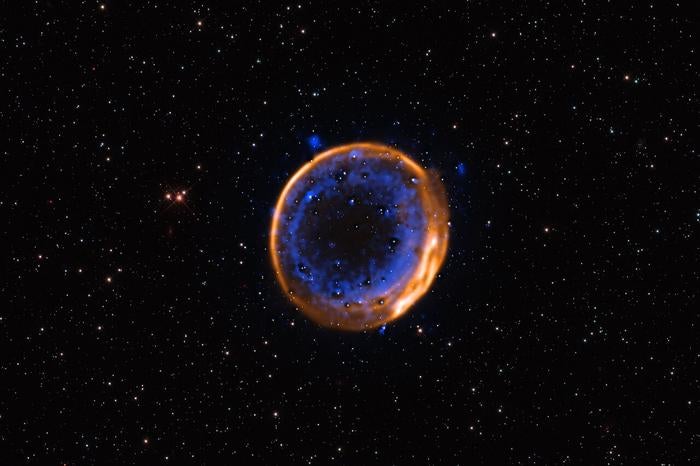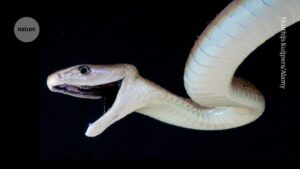
Astronomers have achieved a groundbreaking discovery, capturing the first visual proof of a star exploding twice—a phenomenon known as a double detonation supernova. This revelation, made possible by the European Southern Observatory’s Very Large Telescope in Chile, is reshaping our understanding of stellar explosions.
Led by Priyam Das, a PhD student at the University of New South Wales Canberra, the research focused on the supernova remnant SNR 0509-67.5. The findings, published in Nature Astronomy, provide the first visual evidence of a double detonation in a white dwarf star, challenging previous theories about these cosmic events.
The Power of White Dwarf Supernovae
Unlike the common belief that supernovae only originate from giant stars, some actually emerge from white dwarfs—dense remnants of stars similar to our Sun. These white dwarfs can trigger Type Ia supernovae, known for their consistent brightness, which astronomers use as cosmic measuring tools to gauge the universe’s expansion.
“The explosions of white dwarfs play a crucial role in astronomy,” says Das. Type Ia supernovae have been instrumental in discovering that the Universe is expanding at an accelerating rate, a finding that earned the 2011 Nobel Prize in Physics. Additionally, these explosions are responsible for creating most of the iron on Earth, linking the iron in our blood to ancient star deaths.
Despite their significance, the exact mechanism behind these explosions has puzzled scientists. The prevailing theory suggested that a white dwarf accumulates material from a companion star until it reaches a critical mass and explodes. However, this theory could not account for all observed supernovae, prompting astronomers to consider alternative explanations.
Uncovering the Double Detonation
Recent research has confirmed the possibility of a two-step detonation process. Initially, the white dwarf gathers helium from its companion star, forming a helium shell. When this shell becomes unstable, it ignites, sending a shockwave into the star’s carbon-oxygen core. This shock triggers a second, more powerful explosion that ultimately destroys the star.
Ivo Seitenzahl, who led the observations at Germany’s Heidelberg Institute for Theoretical Studies, explains that these findings demonstrate that white dwarfs can explode before reaching the “Chandrasekhar limit,” the mass previously thought necessary for a Type Ia supernova.
“This breakthrough came from studying calcium patterns in the supernova remnant,” says Seitenzahl. The Multi Unit Spectroscopic Explorer (MUSE) instrument detected two shells of calcium in SNR 0509-67.5, a clear signature of a double detonation.
Scientists had predicted these calcium layers: one from the helium blast and another from the core explosion. The presence of both layers provides direct evidence of this two-step process.
What Simulations Reveal
Simulations have long suggested the possibility of a double detonation. In this scenario, the helium shell burns first, creating elements like sulfur and calcium. The core then explodes, producing heavier elements such as iron and nickel.
The density within the core determines which elements form. High densities favor iron, while slightly lower densities produce calcium. If the density is too low, only lighter elements like oxygen or neon are formed.
“Explosion models predict that calcium should appear in two separate layers,” explains Das. “This is exactly what was seen in the new observations.”
The double shell structure was captured in SNR 0509-67.5 after approximately 29 hours of telescope observations, offering the clearest evidence yet of the double detonation mechanism at work.
Why This Matters for Astronomy
These results are crucial as they address a longstanding mystery about Type Ia supernovae. Their consistent brightness allows astronomers to measure vast cosmic distances, but a lack of understanding about their explosions could skew these measurements.
The new findings challenge the assumption that all Type Ia supernovae result from white dwarfs reaching a uniform mass limit. Instead, some may explode at lower masses through this double-detonation mechanism, explaining variations in supernova brightness and refining models of the Universe’s expansion.
While there have been hints of double detonations in the past, such as high-velocity features in supernova spectra, these were insufficient to prove the theory. The spatially resolved image of calcium layers now provides the definitive proof astronomers needed.
The Beauty of Exploding Stars
For Das, the discovery transcends mere data. “This tangible evidence of a double-detonation not only contributes towards solving a long-standing mystery, but also offers a visual spectacle,” he says. The double explosion creates a “beautifully layered structure,” revealing the secrets of cosmic death in vivid detail.
Understanding how stars die teaches us about the evolution of the Universe and the origins of the elements within our bodies. It proves that even in death, stars contribute to the life around them.
As telescopes become more advanced, astronomers hope to uncover even more about the life and death of stars. For now, the discovery of the double detonation has provided science with a new lens through which to view the cosmos.






